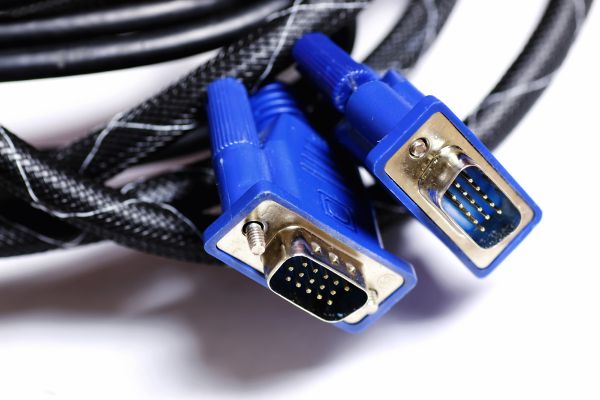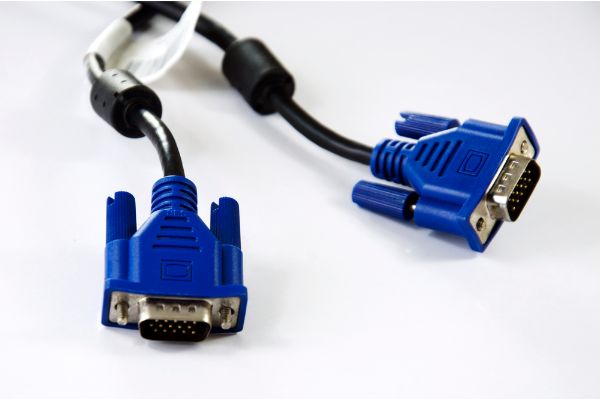Disclaimer: This post may contain affiliate links, meaning we get a small commission if you make a purchase through our links, at no cost to you. For more information, please visit our Disclaimer Page.
As technology has progressed over the years, developers and inventors have created new ways to bring audio, video, and a host of other mediums to consumers. You may be familiar with HDMI inputs and outputs already, and many people in the tech world hold them up as a standard for helping two devices interface and share data easily. However, before HDMI, other connector types existed.
The video graphics array connector, otherwise something many will abbreviate as VGA, is one such type. Even today, some devices or people may still use VGA cables. This type of connector was quite popular during the early days of high-definition televisions, and it allowed those monitors to display images in a higher quality than they would otherwise be able to through an HD15 connection.
Because some people still carry and use these kinds of cables today, they wonder if there is ever a point at which they can go bad. We will discuss this topic in detail in our article. As we get into the subject, we can try to make some educated guesses as to how long your typical VGA cable should last, particularly under normal conditions for its use.
Furthermore, we can take a look at some of the common signs of a VGA cable that is on its way out, talk about the overall quality of different cable models, and discuss some troubleshooting you might be able to do in order to fix your own VGA cable.
Table of Contents
Can VGA Cables Go Bad?
Technically, VGA cables can go bad. However, the most common ways they might stop working usually have little to do with the cables themselves.
Of course, there are always some caveats you have to consider, and defects during the build process could be one such problem.
If there is any issue with the wiring or connectors at the time of its manufacture, a particular video graphics array cable might fail within a few months or years of its purchase date.
However, this sort of thing is far less likely to happen in cables that are structurally sound and functioning as intended.
Before we get into how VGA cables might go bad, it is important to note some of the differences between your typical cable and other computer parts or accessories with which you may be familiar. In various articles, we speak often about how certain components have shelf lives or expected spans in which you should be reasonably certain they will perform well.
This is because most computer parts or accessories have delicate circuitry that could strain itself or moving parts that might break if you aren’t careful. A typical cable array doesn’t usually suffer from these issues. Power does move through the cable, but one that transfers data between two devices doesn’t need to use that much energy. Therefore, there is much less chance of anything inside the cable overloading and causing a problem.
All that said, there are still physical pins on either end of a VGA cable that you would use to make connections between the ports on your devices. These pins need to keep their particular alignments in order to make such connections effectively.
If there is a physical problem at either end, the VGA cable may not be able to function correctly. When this happens, it may be impossible to get the accessory to work as it should, and you would be dealing with a bad cable.
How Long Do VGA Cables Last?
Although there may not be a way to assess old VGA cables for certain, most modern cables are accessories that their manufacturers expect to last for at least a 3 to 10+ years. The actual life of a particular cable could be long after the maximum use that a company guarantees, however.
You may find posters in online forums who have been using their cables for decades without incident. The range that developers give for their cables has a bit to do with the life expectancy of the parts, but it may have more to do with protections and warranties.
Most businesses that make and sell products want to give a particular range for how long they plan to enforce the terms of their warranties. To do that, they must provide a date range in which warranty coverage may stop at some point.
They do this in case parts or accessories are so old that it is not reasonable to assume that they have failed due to any kind of defect or problem. Age can catch up with many kinds of computer components, although it is more of an issue for those that have tiny circuits or moving parts.
Even so, cables are like any other product, and manufacturers must offer some minimum expectation of how long VGA connectors should be able to function without any problems.
If you have not physically damaged your VGA cable in some way, there is little reason to think it won’t continue working for as long as you might need it. Exceptions may exist, but it is more likely that some other part on the devices you connect using the cable will fail before the connector goes out.
What Are Some Signs of a Bad VGA Cable?
We’ve touched on some of the physical aspects of a VGA cable, and we will go into further detail about that in our next section. For now, we need to discuss other signs that your VGA cable might be failing. In most cases, you will notice problems with the devices you are trying to connect.
Although we may not have a list of every possible sign that a cable is going bad, we can give you some of the most common things that other users encounter.
Here are some of the basic things you can look for to determine a cable fault:
1. VGA cables should help your devices display an image on a monitor. If you see no image, it could be a sign that there is a problem with the cable.
2. Similarly, images that blip intermittently or somehow cause distortions could do so because the connection to the VGA cable is faulty. At its best, the cable should display a solid, clear image on the monitor.
3. Even if you see a solid image that does not distort, it may have a color cast to it. This happens when the tint of the image is an unusual shade. Usually, it fills the whole screen with one shade that goes over the top of the imagery.
4. If you experience any flickering of the images when you’re adjusting the monitor, it could indicate a problem with the VGA cable itself.
5. Moving images on the screen may leave ghost-like effects after they move to a different location.
Can You Fix a Faulty VGA Cable? How Can I Troubleshoot a VGA Cable?
There are some specific tests you can run in order to test for a fault in a VGA cable. However, you need some equipment and experience in order to do all of this successfully.
Although we can give you some general guidelines, we would be remiss if we did not say that it might be more efficient to get a new cable on the secondary market.
VGA cables are not typically expensive, and you can pick up a few from resellers that have good reputations, possibly even with warranties for their products. This assumes that you know the VGA cable is at fault, but it could be a much quicker way to resolve the problem for users who don’t know the inner workings of cables like these.
Before you test or get into the cable, you can look for bent pins or other signs that there is a problem with the physical connection. If you are gentle, and if the damage is not too severe, you may be able to push some pins back into place.
Once you do, you can try to make a more solid connection and see if your problems with image quality go away. If that doesn’t work, here are some more involved steps you can take:
1. You need to test the cable for continuity. To do this, you need a multimeter. Once you have one, you can select the appropriate continuity option on it.
2. Starting with a top corner pin, touch the device to the cable connector and wait for a response. The meter will make a particular sound if the pin is in working order.
3. Continue to repeat this pattern along the rows of pins.
4. Make a note of any pin sets that fail the test.
5. If you find any such faults, you’ll have to cut away some of the insulation to get inside the cable. Once you do, you can find which wires failed the test. Do this by comparing your results to a diagram.
6. Use the device to help you find a break in the wire. Twist the two points where the fault occurred together.
7. Run the test again to see if you get a good result.
Does VGA Cable Quality Matter?
Depending on your use cases, VGA cable quality may not matter, but there are differences between models. Some cheaper cables may use incorrect levels of impedance.
Others may have bad or weak shielding. While you may not need the most expensive model, you should opt for a mid-range one from a reputable brand for the best results.
Conclusion
VGA cables are an old standard, but many people can still use them today. If you find older ones on the market that look like they’re in good condition, they should serve you well. You just need to check for physical damage to the pins, wiring that looks too bent or exposed, and other signs that the cable has seen too much damage.
If you do need to troubleshoot a bad cable, there are ways you may be able to fix it, but some require that you open up the cable itself.


